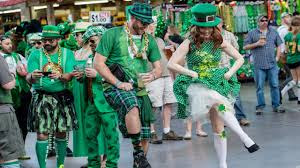St Patricks Day
Consistently on March 17, the Irish and the Irish-on a fundamental level across the globe notice St. Patrick's Day. What started as a strict dining experience day for the supporter holy person of Ireland has become a global celebration observing Irish culture with marches, moving, extraordinary food sources and a ton of green. All the best for a protected, cheerful, and charming day of adoration, harmony and satisfaction.
St. Patrick is perhaps the most notable holy people since his uncommon day has become such a reason for festivity, yet the vast majority don't really know a great deal about him. One stunning goody: even though he's so unequivocally connected with Irish culture and imagery, he wasn't really brought into the world in Ireland. Truth be told, he was brought into the world in Roman Britain in the late fourth or early fifth century. (Here are more authentic realities that are bogus.) As a kid, he was taken to Ireland as a slave. Since it was such a long time ago, a portion of the subtleties of his life are somewhat fluffy and the story shifts relying upon the source. In any case, as per numerous adaptations, he ultimately got away however would get back to Ireland years after the fact and become a cleric, and afterward a diocesan.
He was to a great extent attributed for carrying Christianity to Ireland and assisting with changing many the country's occupants over to the religion. A man of numerous legends that most people have grown up with. For reasons unknown, St. Patrick turned into a magnet for folklore and innovative stories throughout the long term. He was credited including driving the snakes out of Ireland to beginning an Easter huge fire that would never be stifled and still consumes some place in Ireland right up 'til today. Obviously, En-route he likewise some way or another got connected to shamrocks, the shading green, and a large group of different images and customs we currently partner with St. Patrick's Day.
By the present norms, he doesn't meet the standards of sainthood since he was never really sanctified by a pope. (That cycle didn't begin until years and years after his passing.) So, a few fanatics for subtleties will guarantee that he's not an "official" holy person. While they may in fact be correct, he's yet the benefactor holy person of Ireland and adored by his embraced country.
The principal perception of St. Patrick's Day is said to have happened in the 10th or tenth century. It is seen on March 17 since that was accepted to be the date of St. Patrick's passing. It was at first celebrated with worship and such a serious calm and considered more to be a strict occasion. In the long run, it turned into a day that was praised with a dining experience. Years and years prior, the move toward to a greater extent a thrilling festival started to occur. St. Patrick's Day fell towards the center of Lent, yet Catholics were allowed a one-day relief from the typical fasting and order of the period and were permitted to enjoy a wide scope of food and drink, including liquor.
The custom of observing St. Patrick's Day with the celebration of gatherings and marches is broadly accepted to have created in full power not in Ireland, but rather in the United States. Irish migrants were anxious to respect their way of life and praise their public pride. The main St. Patrick's Day march in the United States was held in Boston in 1737, and New York City began its very own motorcade 25 years after the fact.
Basically, drinking on St. Patrick's Day was the aftereffect of two consolidating powers: the day of relief from Lenten fasting and the extravagance of celebrating and festivity. Today, it has become a piece of common culture and a famous practice, one frequently celebrated with green brew or Irish bourbon.




Comments
Post a Comment